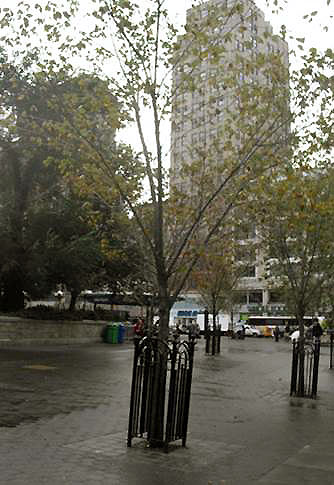Trees Need Dirt
Learning Objectives:
- Identify the current problems with urban forests and discuss why current planting techniques are not adequate in providing a healthy and sustainable environment for urban trees.
- Recognize the key environmental, economic and cultural benefits of urban arboriculture to both private development and public infrastructure projects.
- Discuss the techniques that enable expansion of healthy tree cover within the urban infrastructure and identify how urban tree cover assists in overall project sustainability.
- Describe which LEED® and the Sustainable Sites Initiative™ credits may be obtained through the use of a suspended pavement or soil cell system, and how the suspended pavement or soil cell system provides for a healthier ecosystem for trees within the constraints of most urban environments.
Credits:
According to the National Wildlife Federation and American Forests, both non-profit conservation organizations, “There are over 600 million spaces along city streets where trees could be planted. This translates to the potential to absorb 33 million more tons of CO2 every year, and saving $4 billion in energy costs. A well-maintained urban forest will save a community millions of dollars in storm water runoff expenses, remove millions of pounds of air pollutants and reduce energy costs by millions of dollars.” (1)
The challenge in most urban environments is providing adequate soil conditions for trees to grow and survive. Trees need dirt and this article will outline all the ways that urban forests can be healthier, more sustainable and have greater longevity if provided with adequate growing conditions.
New “green design” and sustainability standards are being developed by communities throughout the US, Canada and Europe. These standards look to improve urban environments by requiring that new development meet sustainable design criteria. Many communities require compliance with the International Green Construction Code (IgCC), LEED® criteria, and Sustainable Sites Initiative™ criteria in addition to meeting the community's newer sustainability codes and standards.
Urban environments present many challenges in meeting these newer sustainability standards and one of the biggest challenges involves the design of sustainable growing conditions. This article will highlight an innovation that helps increase the longevity of urban trees, by providing a more sustainable environment for them. This information is of value to the building architect as well as site design professionals in that a healthy tree canopy adds value to the environmental credentials of a project. A site with a more sustainable urban tree canopy presents environmental benefits to the site and the building, economic benefits to the project, and the client and cultural benefits to the community.
Why Trees Need Dirt in Urban Environments
“Trees need dirt” is a quote from a lecture given by James Urban, FASLA, ISA at a Tree Symposium: Healthy Trees for a Healthy City held in 2004 in Toronto, Canada. (2. -Urban, 2004)
Trees need adequate amounts of dirt or soil to survive and grow, and soil volume and quality have a direct relationship to tree health and sustainability. Adequate soil volume and quality soil content (1) provide a more stable structural base for the tree, (2) increase water availability to the tree, and (3) provide more room for growth and tree longevity. According to James Urban FASLA, ISA, our cities fail in providing environments that are conducive to sustaining urban forests. Generally urban environments provide tree-planting areas that are confined, cluttered with utility lines and filled with compacted, poor quality soils. These challenging conditions have limited tree species diversity in urban areas, compromised tree growth and health, and generally reduced the quality of urban tree cover. These conditions are also presenting challenges for architects and design professionals as they look to meet new sustainability standards for storm water management and meet zoning and planning codes that require denser tree coverage to address heat island effect as well as challenges to communities as they seek environmental, economic and cultural enhancements.
 |
Challenging urban conditions affect the growth and health of urban forests. Photo courtesy of DeepRoot Green Infrastructure |










